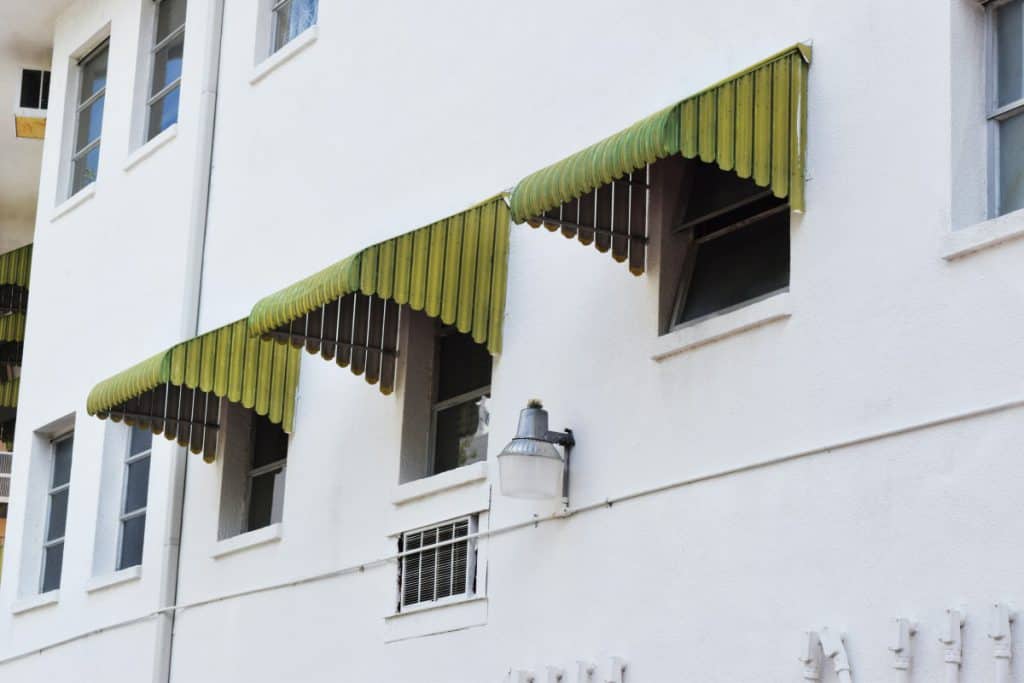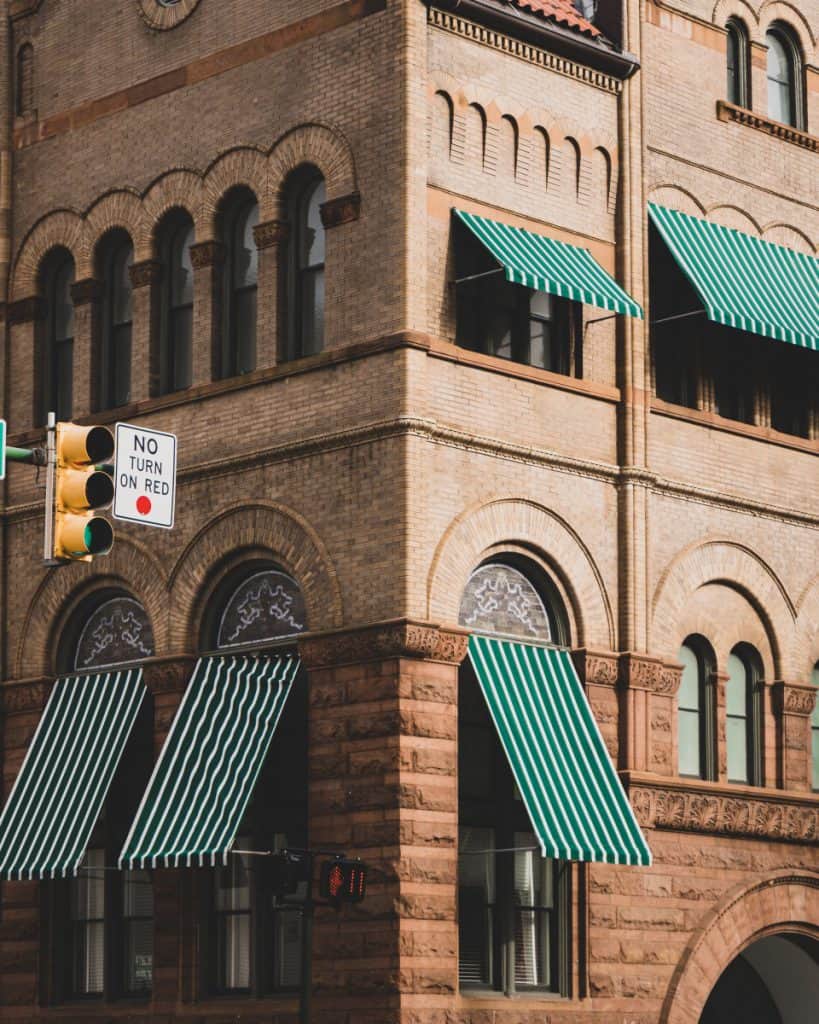People buy awnings for many different reasons. Some do it for the visual appeal that it adds to their homes, while others want to protect their windows or patios from debris and rough weather. One thing’s for sure; most people buy awnings for the comfort that they can provide, particularly on hot summer days.
“As you might already know, awnings come in all sorts of materials, each with its unique strengths. While all of them offer protection from the elements, not all of them handle heat the same way.“
So, to help you figure out which type of awnings get hotter than others, we’ll be taking a closer look at seven of the most popular awning materials available on the market today.
By the end of this article, you’ll be able to choose which awning material is best for your needs.
Let’s get started!

Do Metal Awnings Get Hot?
Yes, metal awnings can get very hot, especially with exposure to direct sunlight.
Metal remains one of the most popular awning materials on the market these days. Usually, that’s because metal is heavier and more durable. Such an awning can withstand strong winds and severe impact from debris like falling tree branches, making them perfect for covering things like cars.
However, if your top priority is managing heat, then metal awnings are probably not the best option you could go for. Yes, metal awnings will provide you with plenty of shade while also absorbing the heat from the sunlight it blocks.
Sadly, some would call metal awnings “heat magnets”. That’s because metal is excellent at absorbing heat but not so good when releasing it back into the environment.
On top of that, metal ones also do not allow any air to pass through, unlike breathable fabric awnings.
So, while the shade under a metal awning can offer some comfort for short periods, it might still get hot and stuffy underneath there after a while.
Do Aluminum Awnings Get Hot?
Yes, aluminum awnings do get hot.
“Aluminum is often a preferred alternative to metal awnings because it’s lighter and cheaper. Still, when it comes to heat, aluminum awnings are somewhat similar to metal ones.“
Firstly, an aluminum awning will provide you with plenty of shade. That’s excellent because it prevents you from burning up under direct sunlight.
However, just like metal awnings, staying underneath aluminum ones all day will eventually get uncomfortable. The material is not breathable, so it traps heat but doesn’t release it as efficiently as fabric awnings.
Here is a silver lining, though. When comparing metal and aluminum awnings, aluminum ones have a much higher heat conductivity than steel.
What does that mean? It means that aluminum is better at getting rid of the heat it absorbs better than steel ones!
So, if you’re looking for an awning material that’s highly durable but also handles heat more efficiently, aluminum might be the choice for you!

Do Acrylic Awnings Get Hot?
No, acrylic awnings don’t get very hot at all.
Acrylic is one of the top choices for people who want to keep cool under their awnings. That’s because it’s a tightly-woven fabric that is ‘breathable’, which means that air can move through it pretty easily. On top of that, acrylic awnings also do a fantastic job at repelling UV rays from the sun.
When you combine all of that, what you get is an awning material that provides you with plenty of shade and lots of comfort. Sitting underneath an acrylic awning will help to keep you and your family cool, even with direct sunlight hitting it from above.
Acrylic awnings come in a few different variations. You can get 100% acrylic awnings, as well as those combined with cotton, polyester, and more. Some manufacturers also use acrylic as a coating for other fabrics to harness their strengths against the sun’s hot rays.
Do Polyester Awnings Get Hot?
Yes, polyester awnings get pretty hot.
Like most other materials, polyester awnings might do an excellent job of blocking out direct sunlight. Unfortunately, the shade isn’t enough as the material doesn’t handle heat very well.
To understand this better, it’s essential to understand what polyester is. Polyester is a man-made, synthetic fibre made from chemicals. When used as a material for awnings, it offers plenty of great benefits like preventing water absorption and preventing mould or mildew growth.
Still, polyester isn’t exactly known for its heat-busting properties. Simply put, if it’s a hot day out, you’re going to feel hot as you sit under a polyester awning.
Do Glass Awnings Get Hot?
Okay, this one can get a bit tricky. Glass awnings by themselves can get very hot because a lot of direct sunlight can get through it without much of a problem. So, by default, you’ll feel very hot while standing underneath a glass awning on a hot day.
However, glass awnings are also very straightforward when it comes to tinting. With the application of a high-quality tint that resists UV rays and heat, the glass awning could actually end up being very cool underneath.
That’s because plenty of glass tints offer a high degree of heat rejection. So, when direct sunlight lands on the tinted glass awning, the heat won’t absorb at all. Instead, it’ll be reflected back towards the sky.
Of course, glass tinting does come at a cost. So, besides what you’ve already paid for the glass awning, you may end up having to shell out a bit more to get it tinted if you’d like it to keep you extra cool.

Do Vinyl Awnings Get Hot?
Yes, vinyl awnings can still get hot.
When choosing the materials for your awnings, you might come across those that have a vinyl coating. Perfect examples of this include vinyl-laminated or vinyl-coated polyester.
“While vinyl awnings can resist harmful UV rays from the sun, they’re unfortunately not that good at keeping you cool while you’re underneath them.“
Like several of the other materials explored in this article, vinyl is not a breathable material. So, while it might absorb some of the heat from direct sunlight, it’s also very good at keeping all of that heat trapped inside the material.
The end result is that you might get to enjoy the shade, but it might not be too comfortable if you’re there for extended periods.
Does A Black Awning Canopy Get Hot?
Yes, black awning canopies get very hot, regardless of the material that it’s made of.
When it comes to awnings and heat, your choice of material isn’t the only factor. Granted, that’s probably the most crucial factor to consider, but you must also think about the colour of the awning itself.
As a general rule of thumb, brightly coloured awnings are much better at reducing heat. That’s because bright colours naturally reflect heat rather than absorb it into the material. As a result, the awning becomes much cooler even when exposed to direct sunlight.
On the other hand, darker-coloured awnings like a black awning canopy will get very hot. As a matter of fact, black is probably the hottest colour there is. Not only does it absorb most of the heat that reaches it, but it’ll also keep that heat trapped for longer.
Bottom line? If you want your awning to help avoid the heat, black is quite possibly the worst colour for that. Instead, stick to pale or bright colours like white, beige and yellow.
Which Awning Material Is Best Against Heat?
If you’re reading this article, then the chances are high that you’re looking for an awning to keep you and your family cool at home. Whether it’s an awning for the window, patio, or anywhere else, the same rules apply.
First of all, it seems that the best awning material that you can go for is either glass or acrylic. For starters, acrylic awnings are known for being some of the coolest ones out there. Simply put, you could stay under an acrylic awning comfortably for extended periods without getting too hot.
Glass, as mentioned earlier, is a little bit tricky. That’s because glass by itself is terrible at blocking heat, but it’s incredibly easy to apply a film or tint to the surface. With that, not only can you upgrade your glass awning to make it more heat-resistant, but you can also choose just how much heat resistance you want!
If money is no issue, you could choose to pay top dollar and get the most powerful, heat-reflecting glass tint available. Or, if you’re on a limited budget, you could go for something mid-range instead.
Still, the material is only one crucial factor here. Regardless of what your awnings are made of, you must also consider their colour. If your top priority is an awning to keep yourself cool, then choose brightly coloured materials. That way, you won’t have to worry about the awning trapping heat.
However, if you were to opt for a darker-coloured dawning like a black one, it will attract and trap plenty of heat no matter what kind of material it’s made of.
Alright, that’s it for this article guys, if you found it useful then a share on social media or your website would be cool!
All the best
Steve
ps here’s a few articles related to this one you might find interesting:
How Much Are Custom Awnings? (3 popular examples with images)

